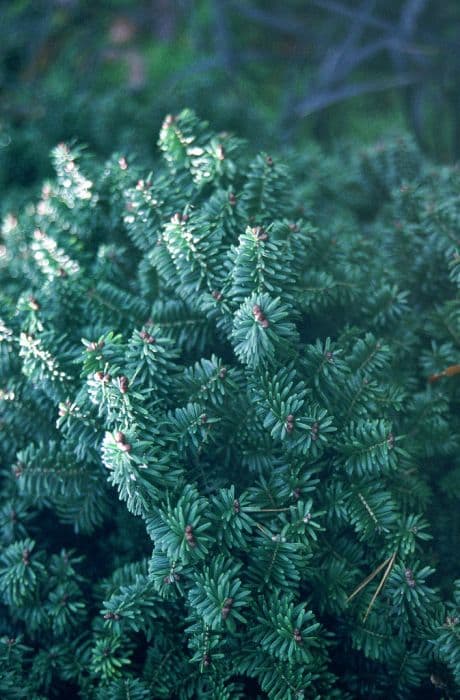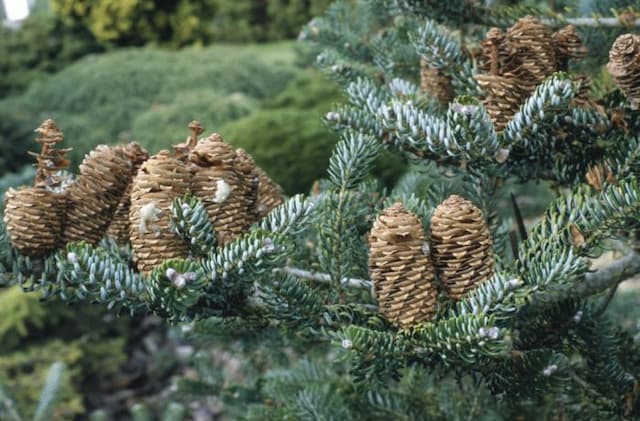Lodgepole Pine Pinus contorta

ABOUT
The plant commonly known as lodgepole pine has a distinctive appearance that is characterized by its evergreen foliage and its rugged, often contorted growth habit, which is where it gets its name from. This pine is well-known for its thin, needle-like leaves that are usually arranged in pairs and are light to dark green in color. These needles can be quite long and are often very stiff and prickly to the touch. The bark of the lodgepole pine is another notable feature; it's typically thin and flaky, often taking on a grayish-brown color that sometimes appears to be tinged with hues of red or orange. As the plant matures, the bark can become more deeply grooved. One of the most distinctive traits of the lodgepole pine is its cones. The cones are relatively small and can sometimes remain on the tree for years. They are unique in that they often require heat, like from a forest fire, to open and release their seeds, a process known as serotiny. The overall shape of the lodgepole pine can vary quite a bit, depending on the conditions it grows in. It can grow with a single straight trunk, but in more extreme or exposed conditions, it may develop multiple trunks or grow at unusual angles, hence the "contorted" description in its common name. The branches are generally sparse at the bottom, becoming denser higher up the tree, which creates a somewhat conical overall shape typical of many pines in forest settings. In essence, the lodgepole pine is a resilient and adaptable plant that embodies the rugged environments it often inhabits, with a distinctively slender and sometimes twisted appearance.
About this plant
 Names
NamesFamily
Pinaceae
Synonyms
Lodgepole Pine, Shore Pine, Twisted Pine, Contorta Pine
Common names
Pinus contorta var. latifolia, Pinus contorta var. murrayana, Pinus contorta var. contorta.
 Toxicity
ToxicityTo humans
Lodgepole Pine (Pinus contorta) is not known for being toxic to humans. There are no significant toxic effects associated with this species if ingested in small amounts. Normal contact, such as touching or handling, does not pose a risk either. However, as with any plant material, individual allergies or sensitivities can occur, and ingesting large quantities of pine needles or other tree parts can potentially lead to digestive discomfort or more serious health issues due to the physical nature of the material, not from chemical toxicity.
To pets
Lodgepole Pine (Pinus contorta) is typically not toxic to pets. It is not listed among the commonly known toxic plants that pose a risk to domestic animals such as dogs and cats. Nevertheless, ingestion of pine needles can be harmful due to the potential for physical injury to the digestive system or intestinal blockage, not because of chemical poison. If a pet ingests large amounts of pine needles or wood, it may exhibit signs such as vomiting, diarrhea, or abdominal pain, and veterinary attention should be sought.
 Characteristics
CharacteristicsLife cycle
Perennials
Foliage type
Evergreen
Color of leaves
Green
Height
40-150 feet (12-46 meters)
Spread
20-30 feet (6-9 meters)
Plant type
Tree
Hardiness zones
3-7
Native area
North America
Benefits
 General Benefits
General Benefits- Erosion control: Pinus contorta, commonly known as lodgepole pine, has a root system that helps stabilize soil and prevent erosion.
- Wildlife habitat: It offers shelter and nesting sites for various species of birds and mammals.
- Timber production: Lodgepole pine is harvested for its wood, which is used in construction, manufacturing, and for paper products.
- Reforestation: Due to its adaptability and growth in a variety of soils, it is often used in reforestation efforts.
- Aesthetic value: With its distinctive shape and foliage, the lodgepole pine is valued for its visual appeal in natural and landscaped areas.
 Medical Properties
Medical Properties- Antiseptic - The resin of Pinus contorta has antiseptic properties and may be used for treating minor cuts and wounds.
- Anti-inflammatory - Compounds in Pinus contorta may have anti-inflammatory effects, potentially useful for alleviating muscle pain and arthritis.
- Expectorant - The plant has been traditionally used to help loosen phlegm and ease breathing.
- Topical Skin Treatment - Oils or salves made from the plant have been used to treat skin conditions like eczema or psoriasis.
 Air-purifying Qualities
Air-purifying QualitiesThis plant is not specifically known for air purifying qualities.
 Other Uses
Other Uses- Lodgepole pine's resin can be used to waterproof baskets and boats, due to its water-resistant properties when hardened.
- The straight trunks of lodgepole pine make them suitable for traditional Native American lodge construction, hence its common name.
- Thinner poles from this pine are utilized for making tipi-like structures in outdoor educational programs for teaching about indigenous cultures.
- Lodgepole pine cones can be used in decorative arts and crafts, often as part of wreaths, bird feeders, or as Christmas ornaments.
- The wood from lodgepole pine serves as raw material for manufacturing musical instruments like guitars, due to its acoustic properties.
- The fine-grained texture of the pine makes it a popular choice for wood carving and making small wooden figures or toys.
- Due to its abundance, this pine's wood chips and sawdust are used in gardening as a mulch to maintain soil moisture and control weeds.
- Lodgepole pine is used in the production of particleboard and other engineered wood products, utilizing the wood's uniform texture and workability.
- When dried, the needles of the lodgepole pine can be used as a natural source of tinder for starting fires in outdoor situations.
- In craft papermaking, the fibers of lodgepole pine can be processed into a specialty paper with a unique texture and color.
Interesting Facts
 Feng Shui
Feng ShuiThe Lodgepole Pine is not used in Feng Shui practice.
 Zodiac Sign Compitability
Zodiac Sign CompitabilityThe Lodgepole Pine is not used in astrology practice.
 Plant Symbolism
Plant Symbolism- Adaptability: Pinus contorta, commonly known as Lodgepole Pine, is known for its ability to grow in a variety of soil types and conditions, symbolizing adaptability and resilience.
- Resilience: With its twisted and contorted trunk, the Lodgepole Pine exemplifies endurance and the ability to withstand harsh environments and adversity.
- Regeneration: After forest fires, Lodgepole Pine cones release their seeds, making this tree a symbol of renewal and rebirth following destruction or hardship.
- Versatility: The Lodgepole Pine is utilized in a variety of ways by Native American tribes, from building materials to medicinal purposes, representing versatility and usefulness.
- Purity: In some cultures, evergreen trees like the Lodgepole Pine are seen as symbols of purity and eternal life due to their year-round foliage.
 Water
WaterLodgepole Pine requires moderate watering, especially during its establishment phase. Once established, it is quite drought-tolerant. Typically, watering deeply every two weeks with about 1 to 2 gallons of water is sufficient during dry periods. Ensure the soil around the tree is well-drained to prevent waterlogging. In the cooler seasons, reduce the frequency of watering to account for slower soil moisture depletion.
 Light
LightLodgepole Pine thrives best in full sunlight. It prefers an open location where it can receive at least six hours of direct sunlight daily. Avoid planting in heavily shaded areas to ensure the health and growth of the tree.
 Temperature
TemperatureLodgepole Pine is hardy and can tolerate a temperature range from -40 to 90 degrees Fahrenheit, but it grows best in cooler climates with a temperature between 60 and 75 degrees Fahrenheit. Ensure it is planted in a site where it is sheltered from extreme heat or cold winds.
 Pruning
PruningPruning Lodgepole Pine can help maintain its shape and reduce the risk of disease by removing dead or diseased branches. Pruning is best done in late winter to early spring before new growth begins. Avoid heavy pruning; instead, focus on cutting away damaged or unnecessary branches to enhance air circulation and sunlight penetration.
 Cleaning
CleaningNot needed
 Soil
SoilLodgepole Pine prefers well-draining soil with a mixture of sand, loam, and peat moss, mimicking its natural environment. The ideal soil pH for Lodgepole Pine should be slightly acidic, around pH 5.0 to 6.0.
 Repotting
RepottingLodgepole Pine, being a slow-growing conifer, doesn't require frequent repotting. You may repot every 2-3 years or when root-bound to a larger container with fresh soil to encourage growth.
 Humidity & Misting
Humidity & MistingLodgepole Pine thrives in moderate to low humidity levels, typical of its natural habitat. It does not require high humidity and can tolerate dry air, making it suitable for most outdoor environments without the need for humidity adjustments.
 Suitable locations
Suitable locationsIndoor
Ensure bright light, cool temps, and air movement for Lodgepole Pine.
Outdoor
Plant in full sun, well-draining soil, and water deeply but infrequently.
Hardiness zone
4-8 USDA
 Life cycle
Life cycleLodgepole pine (Pinus contorta) begins its life cycle as a seed, often released from serotinous cones which open in response to the heat of forest fires. Upon germination, the seedling emerges, establishing roots and a shoot that will develop into a juvenile tree. During the sapling stage, the young lodgepole pine continues to grow in height and girth, developing its characteristic thin, flaky bark and needles. The tree reaches maturity and enters its reproductive stage, producing male and female cones; male cones release pollen which is carried by the wind to fertilize female cones. Over time, mature lodgepole pines may become part of a dense forest stand, competing for light and nutrients. Eventually, the tree will die, falling to the forest floor and decomposing, thereby returning nutrients to the soil and completing its life cycle.
 Propogation
PropogationPropogation time
Spring to early summer
The most popular method of propagating the lodgepole pine (Pinus contorta) is through seed collection and sowing. Timing is critical, with the best period being late winter to early spring. Mature cones should be collected and then dried in a warm place to facilitate the release of seeds. Once the seeds are extracted, they must be stratified, which typically involves keeping them in a moist substrate at a cold temperature, roughly 34 to 40 degrees Fahrenheit (1 to 4 degrees Celsius), for about 60 days to mimic winter conditions and break dormancy. After stratification, seeds are sown in well-draining soil and exposed to full sun, where they germinate and grow into seedlings that can later be transplanted to their permanent location once they have sufficiently matured.









